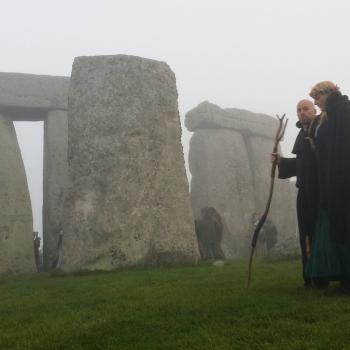What if, early on, the church had decided to always gather outdoors instead of in buildings? How would the church and world look different?

Take a tour of Christendom, and you can visit beautiful basilicas and stunning sanctuaries dating back to antiquity. Go to church this coming Sunday, and I’ll lay you odds that you’ll step through the doors into an air-conditioned chancel that protects you from the elements as you lift your heart in song. Through the centuries, church buildings have served as places of worship, community and civic centers, and more. Whether it’s the “church in the wildwood,” a bishop’s seat, no doubt, when you think of a place of Christian worship, you think of a building.
But, did you ever wonder what an alternate history might have looked like if the religion of Jesus had never taken shelter indoors? How would the world be different today? And, what, if anything, can we do to remedy our disconnect from nature?
An Outdoor Religion
If Christianity had remained outside, it would have maintained its essential doctrines without experiencing a disconnect from the natural world. If you think about it, nothing essential to the Christian faith resides in the existence of church buildings. Dogma does not depend on wood or stone. As the song goes, “The church’s one foundation is Jesus Christ, her Lord.” No building is required for the Church to be the Church. We might just as easily have developed as an outdoor religion as an indoor one.
Yet, in its current method of indoor worship, the church separates believers from the natural elements. If Christianity had developed as an outdoor religion, it’s cathedrals might have been oak groves and pine forests, it’s churches wave-worn beaches and desert vistas. On any given Sunday morning, you might choose to attend worship in a bathing suit or parka, raincoat or sun hat, depending on the elements. Our buildings have made worship more predictable, but has that made the Church unfortunately tame? How gloriously wild might we be if we had remained an outdoor religion?
Earth-Based Spirituality
If the Church had grown up outside, earth-centered followers of Jesus would have developed a spirituality more tied to creation as a process. Instead of insisting on a literal six-day explosive creation, believers would embrace the slowness and rhythms of nature. They would see themselves as a part of the world’s process, not the pinnacle of her progress. The elements of worship might include earth, air, fire, and water in addition to bread and wine. Beyond a merely human congregation, church attendees might include birds and beasts, fish and insects. If our gatherings were out-of-doors, choirs would join the chorus of birds and babbling streams. Humanity would worship together with nature, not separated from it.
Ecological Awareness
As a result of a greater connection to sacred soil, the outdoor church would have been gloriously grounded in ecological awareness. Christian entrepreneurs would not have sought ways to exploit the earth, but to tend it. This earth-husbandry was, after all, the original and divine purpose of humanity in Eden. Had the church not lost sight of our natural connection, the earth would have been much better off today.
Heathen Christianity
If Christianity had formed as an outdoor religion, it would not have othered the peoples and nations it encountered as it expanded across the globe. Instead of positioning itself in opposition to Pagans, Christianity would have embraced the residents of the heath. Heathen Christianity, in turn, would have practiced peace rather than taking up the sword of empire. It would have made friends rather than enemies.
Returning to Earth-Care
We have lost so much by abandoning the outdoors! How can we regain our sense of natural wonder and return to caring for the Earth?
By returning our worship to a natural setting.
In the early days of the faith, Christians gathered in hidden caves, by sacred pools, and beneath pillars of trees. If we gather again in these natural settings, even periodically, this will reconnect us to the sacred earth.
By encouraging individual exploration of the world’s wild places.
As shamans go on vision quests, today’s disciples can follow Jesus’s example of wandering in the wilderness. Not everyone has the luxury of spending forty days in the desert like Jesus did, but you can make camping and hiking a spiritual practice as your schedule allows.
By taking up ecology as a sacred discipline.
Earth care is more than a fad or fashion; it is crucial to our own survival. Christians have done more damage to the planet than any other group. We made the mess, so it’s our responsibility to clean it up. For individuals, this can mean recycling and adopting a highway. For Christian business owners, it involves finding best practices to limit litter, dispose of debris, and eliminate effluvium in a way that preserves the planet. Ecology isn’t just a civic responsibility; it’s a holy obligation.
By becoming conscientious consumers.
Buying local reduces fuel consumption associated with shipping. Purchasing products made from renewable or recycled resources means a more sustainable supply. Selecting fair trade and ethically sourced goods means sharing the wealth with some of the world’s poorest people. These are just a few suggestions of how you can return to Earth-care as a part of your religious life.
Spirituality of the Sacred Earth
When the Church decided to build indoor sanctuaries, it abandoned natural cathedrals and exchanged them for sterile structures. As artistic as they are, these edifices of human religion cannot replace the grandeur of the natural world.
Though it’s impossible to turn back the clock and ban the construction of church buildings, we can reclaim the wonder and glory of natural religion. If we repent from our reliance on sterile structures, we can return to Eden and regain a spirituality of the sacred earth.













